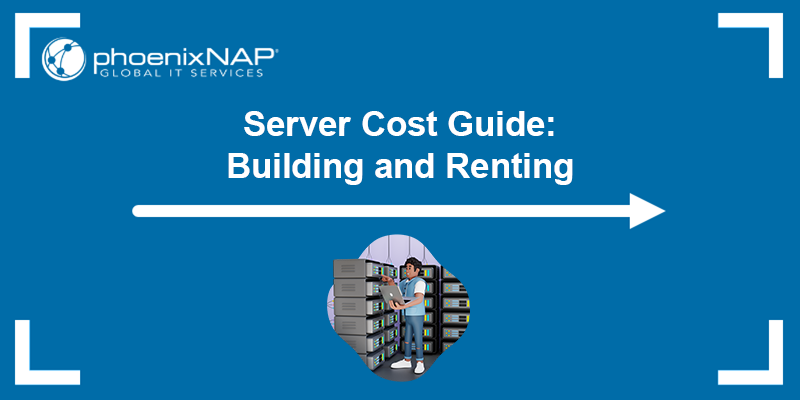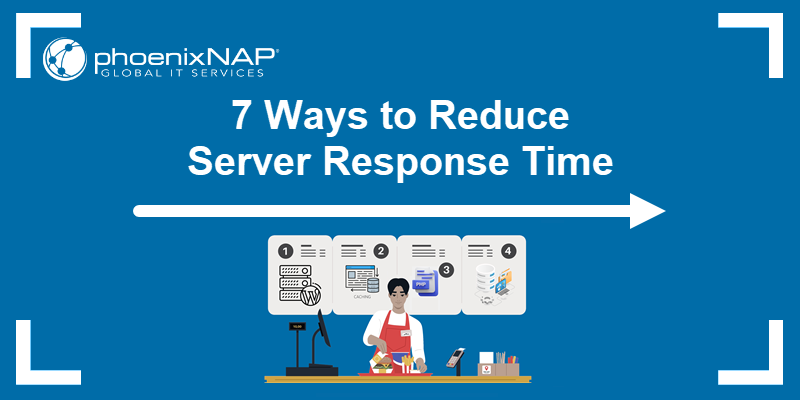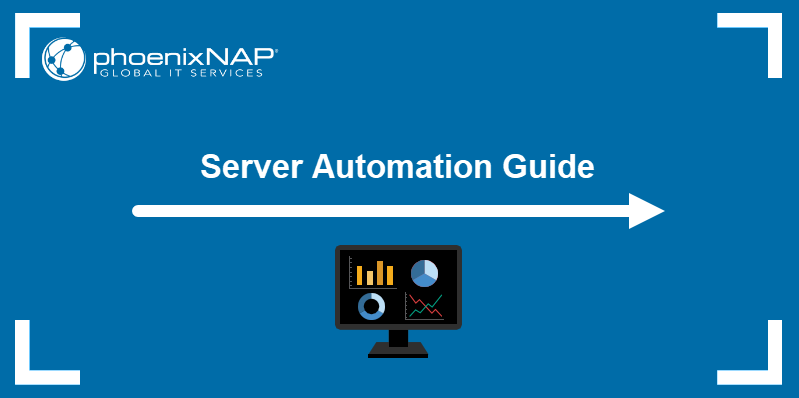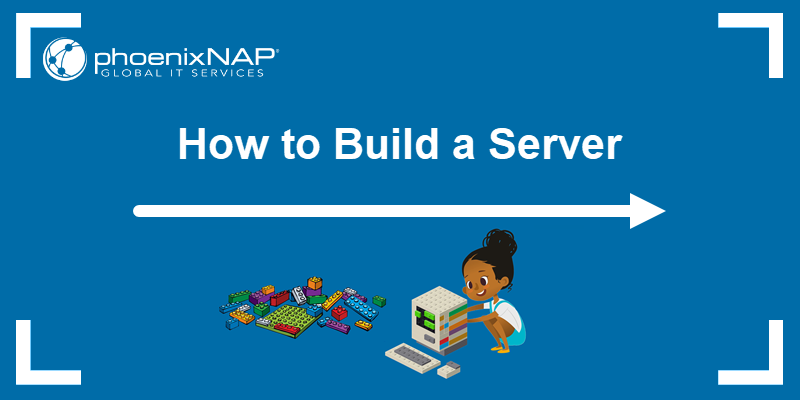A server's software stack largely determines its function, the hardware resources it requires, and how it integrates with the rest of the infrastructure.
Before provisioning a server, you must decide which core software components, such as database systems, hypervisors, or load balancers, must be deployed within the network topology.
This guide lists popular server software options and explains how these solutions support specific server roles.
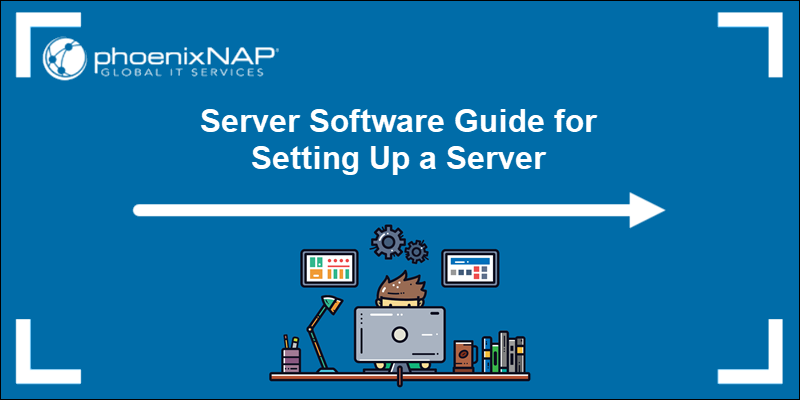
What Is Server Software?
Server software is a set of programs and supporting data that enable a server to respond to incoming client requests and deliver services over a network.
These software solutions can run on physical servers, virtual machines (VMs), or containers, regardless of whether the server is deployed in a colocation facility, cloud environment, or on-prem data center. Examples of server software include:
- Apache/Nginx/IIS. Web server software serves websites and web applications by handling incoming HTTP/HTTPS client requests.
- MySQL/PostgreSQL/MariaDB. Database management systems (DBMS) allow users to query databases, store structured and unstructured data, and manage roles and access control.
- Postfix/Microsoft Exchange. Email server software is used in enterprise environments to send, receive, and store large volumes of email communication.
- Samba. File-sharing software enables secure file sharing across a network and is commonly used for internal file servers.
- VMware ESXi/Hyper-V. Virtualization platforms are used to deploy virtual server environments and manage multiple VMs on a single physical machine.
- Docker/Kubernetes. Containerization and orchestration platforms package, deploy, and manage applications in small, isolated environments across server clusters.
- Node.js/Apache Tomcat. Application server software runs server-side logic, APIs, and backend services in business or development environments.
- BIND/Microsoft DNS. Domain Name System(DNS) software translates domain names into IP addresses on public networks or private DNS servers.
- Let's Encrypt/Certbot. Specialized tools automate HTTPS encryption and enable admins to issue and renew SSL/TLS certificates on web servers.
- Squid/Varnish/Redis. Caching and proxy solutions that improve web performance by storing frequently accessed content and reducing bandwidth usage.
This list highlights some of the most well-known and widely used server software, but is by no means comprehensive. The following sections provide a more detailed account of different solutions organized by specific server roles.
How Does a Server Work?
Servers are configured to perform specific functions based on their role in the network. Their capabilities depend on the installed server software and available hardware resources.
Server software enables a machine to listen for requests, respond to clients, and perform designated operations. The interaction is governed by the client-server model that works as follows:
1. Devices or applications (clients) initiate requests to the server over a network, asking it to deliver content, store data, authenticate users, or perform other tasks.
2. The server software continuously listens for inbound client requests on specific network ports and can handle multiple concurrent requests using multithreading or asynchronous I/O.
3. Based on the type of request, the server passes it to the relevant local software component for processing or forwards the request to another upstream server.
4. The server generates a response and sends it back to the client as a webpage, file, confirmation message, or structured data output.
5. This request-response loop runs continuously to support real-time interaction between applications and services.
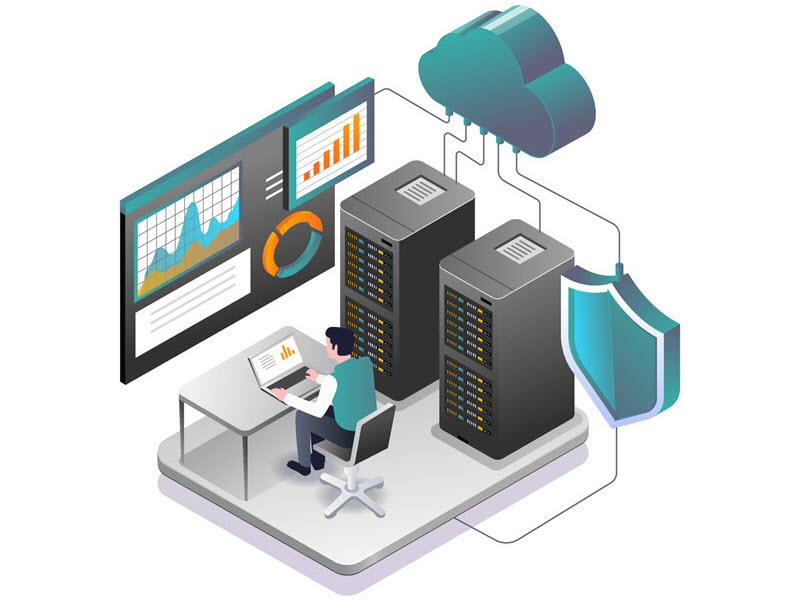
During this process, supporting software tools on the server monitor this activity and record performance metrics and events for later analysis and troubleshooting. Many servers also have load balancers and failover mechanisms to distribute traffic evenly and ensure uptime during heavy workloads.
Server Operating Systems
The first software you are likely to install on a dedicated server is a server operating system (OS). The operating system allows you to manage the server's hardware and system resources and is a foundation for running other server software. While many server operating systems exist, Linux dominates the market with a share of almost 80%.
Major server operating systems include:
- Linux. Linux is a free and open-source operating system known for its flexibility, small footprint, and rich ecosystem. Though it requires technical knowledge to install, configure, and maintain, it is the first choice for most server deployments. Some of the most popular Linux server distributions are Ubuntu Server, Debian, Fedora, OpenSUSE Leap, SUSE Linux Enterprise Server, and Arch Linux.
- Windows Server. Developed by Microsoft, Windows Server is a commercial OS built for enterprise-grade workloads. It supports a wide range of Microsoft applications and services, includes a full desktop GUI, and integrates tightly with Active Directory, Hyper-V, and PowerShell. It's a logical choice for organizations already using Windows infrastructure.
- RHEL. Red Hat Enterprise Linux (RHEL) is a subscription-based Linux distribution developed and maintained by Red Hat. It offers long-term support, guaranteed compatibility with enterprise applications, and access to Red Hat's support services and management tools.
- FreeBSD. FreeBSD is a free and open-source Unix-based OS that includes a complete and integrated system, including the kernel, drivers, and userland tools. It is known for its performance, advanced networking stack, and strong security model. FreeBSD is often used as a platform for deploying firewalls, storage servers, and high-performance web servers.
Note: If you are still unsure which operating system to choose, read our guide for a detailed comparison of server OS options and their ideal use cases.
Server Operating Systems: How to Choose
Choosing a server operating system directly impacts which software components you can install and how reliably they run. Additionally, some tools and services are only compatible with specific OS families, and even when they do run across platforms, you may encounter issues during updates or long-term maintenance.
When choosing an OS, pay special attention to the following features and functions:
- Workload type. What type of server are you planning to deploy: a web server, database server, mail server, or file server? Each server type requires a different technology stack and has specific software and resource needs.
- Compatibility with existing infrastructure. If your current infrastructure is Windows-based, deploying a Linux server may introduce integration challenges. Therefore, aim for consistency unless you have specific reasons to mix OS environments.
- Hardware requirements. Ensure your hardware can meet the demands of the OS and the applications it will run.
- Server role. Determine whether the server will be dedicated, host specific applications, or function as an edge server. The role influences the performance, OS footprint, and administrative overhead required.
- Security requirements. If you are handling sensitive data, choose an OS that supports robust and automated security features like built-in firewalls and access controls or supports security frameworks like SELinux or AppArmor.
- Support lifecycle. Consider which operating system offers long-term support, especially for paid enterprise solutions. Avoid deploying systems that are close to end-of-life (EOL), as upgrading later may require a full redeployment.
- Licensing and cost. While free and open-source options are popular, paid operating systems often provide formal support, stability, and certification for enterprise applications. Also, review licensing terms; even some "free" operating systems have restrictions based on usage scenarios.
- Ease of use. Linux systems often require more technical expertise than Windows. Evaluate the technical capabilities within your organization before committing to a particular OS.
- Integration and compatibility. Not all applications are compatible across all operating systems. Check software requirements and supported environments to avoid issues with key tools or services.
- Platform features and extensibility. Consider native support for features like package managers, virtualization tools, and container orchestration tools like Docker or Kubernetes. These affect long-term scalability and flexibility.
The following table provides a quick comparison of different operating systems:
| Feature | Linux (General) | Windows Server | RHEL | FreeBSD |
|---|---|---|---|---|
| Workload Type | Web, database, DNS, mail, file servers, DevOps, containers. | Web, file, print, AD, .NET, enterprise workloads. | Enterprise-grade web, DB, cloud, certified business apps. | High-performance web, firewalls, storage, and routing. |
| Compatibility with Infrastructure | Best for open ecosystems; not ideal for Windows-native setups. | Ideal for Microsoft environments; integrates tightly with AD, Exchange, and .NET. | Designed for large-scale Linux-based enterprise setups. | Less common in mixed environments; works best in BSD-only stacks. |
| Hardware Requirements | Low to moderate footprint. | Moderate to high requirements depending on version and GUI. | Requires enterprise-grade hardware in some cases. | Lightweight and efficient. |
| Server Role Flexibility | Highly flexible; supports nearly any server role. | Suited for GUI-based roles, file and print services, and hybrid AD networks. | Best for mission-critical, long-life-cycle servers. | Specialized: excels in edge, security, and storage use cases. |
| Security Features | Strong; SELinux, AppArmor, iptables, nftables. | Built-in Defender, Group Policies, BitLocker. | Advanced security policies, hardened kernel, SELinux. | Secure by design; includes ipfw and jails for isolation. |
| Support Lifecycle | Varies by distro, for example, 5–10 years for Ubuntu LTS. | ~10 years (5+5 with Extended Support). | Up to 10+ years with EUS (Extended Update Support). | Community-driven; long-lived but less formalized. |
| Licensing & Cost | Free and open-source (mostly); some enterprise editions have paid support. | Commercial; licensed per user or core. | Subscription-based model (paid). | Completely free and open-source. |
| Ease of Use | CLI-based; primarily for advanced users, but some distros (e.g., Ubuntu) are user-friendly. | Very user-friendly; full GUI; low learning curve. | CLI-focused; better for trained sysadmins. | Steep learning curve; minimal GUI; advanced users only. |
| Integration & Compatibility | Great open-source software support; some proprietary software may lack compatibility. | Excellent Windows software compatibility; limited open-source flexibility. | Certified for many enterprise apps; strong compatibility with vendors. | Limited third-party app support; strong BSD-native toolchain. |
| Platform Features & Extensibility | Extensive package managers (APT, YUM, DNF, pacman); Docker, Kubernetes, KVM. | Built-in Hyper-V, PowerShell, Windows Containers. | Podman, Docker, OpenShift, certified repos. | Ports system, jails, bhyve hypervisor; fewer third-party integrations. |
| Community / Support Model | Huge global community; paid support is optional via vendors. | Microsoft commercial support. | Enterprise-grade support from Red Hat. | Small but technically strong community. |
Types of Servers
When setting up a server, admins often need to install multiple software components to enable the system to perform its intended role.
The required software depends on the deployed server type. For example, a web server, database server, or gaming server relies on different technology stacks. The following section lists standard technology stacks used for various server roles.
Web Server
Web server software components handle incoming HTTP or HTTPS requests, interpret them, locate the correct resources, and deliver web content to client web browsers.
Popular web server software includes:
- Apache HTTP Server. Apache is widely used in both Linux and Windows environments. It is free and open-source, with extensive configuration options and broad compatibility.
- NGINX. A lightweight, high-performance web server. It is primarily used to serve static content and is known for its load balancing, reverse proxy capabilities, and handling of concurrent connections.
- Microsoft IIS. A proprietary web server developed by Microsoft, integrated tightly into Windows environments. Commonly used in enterprise infrastructures running on Windows Server.
- LiteSpeed. A commercial web server focused on speed and scalability. Compatible with Apache configurations and widely used in cPanel-based hosting and high-traffic websites.
A fully functional web server stack needs additional components besides the web server software. For instance, it usually includes multiple software layers for data storage, security, scripting, and content delivery.
The following table lists possible example technology stacks for setting up a web server:
| Web Server | Stack Example | Operating System | Scripting Language | Database Management System | SSL Tool |
|---|---|---|---|---|---|
| Apache | LAMP | Linux | PHP, Python | MySQL, MariaDB | Let's Encrypt, Certbot |
| NGINX | LEMP | Linux | PHP, Python, Go | MariaDB, PostgreSQL | Certbot, OpenSSL, Let's Encrypt |
| Microsoft IIS | WIMP | Windows Server | ASP.NET, .NET Core | MSSQL, Azure SQL | Built-in, Custom CA |
| LiteSpeed | CyberPanel | Linux | PHP | MySQL (Apache-compatible) | Built-in ACME, Certbot |
Application Server
Application server software executes backend code, interacts with databases or APIs, manages user sessions, and enforces business rules. A web server routes client requests to the application server, which processes them dynamically and returns real-time responses.
For example, when a user tries to log in, the web server forwards the request to the application server, which handles authentication and returns a response via the web server back to the client.

Examples of application server software include:
- Apache Tomcat. A lightweight and open-source application server that provides a runtime environment for deploying Java-based web applications.
- WildFly. An open-source application server that supports the Java EE specification. It is well-suited for large-scale Java applications, with native integration with Kubernetes and OpenShift.
- NGINX Unit. A dynamic application server that seamlessly integrates with Nginx. It supports multiple languages and frameworks, including Python, PHP, Ruby, and Go.
- Express.js. A minimalist and widely used framework for building APIs and web applications in Node.js.
- Microsoft IIS with .NET Core. IIS integrates with the .NET Core framework to act as an application server. This configuration is commonly used for web apps in Windows-based environments.
- Kestrel. A high-performance, cross-platform server used for ASP.NET Core applications. It is often deployed behind a reverse proxy such as NGINX or IIS.
- Puma. A concurrent Ruby application server is often used to run Ruby on Rails applications.
A complete application server setup often includes a web server, application server, scripting runtime, and database. The following table lists example technology stacks used to deploy application servers:
| Application Server | Stack Example (Components) | Reverse Proxy | Containerized Deployment | Used For |
|---|---|---|---|---|
| Apache Tomcat | Spring MVC App (Java: Servlets/JSP, PostgreSQL or MySQL). | NGINX, Apache HTTP | Docker, Kubernetes | Java Servlets, JSP, Spring Apps |
| WildFly | Jakarta EE Stack (WildFly, Java EE APIs, PostgreSQL or Oracle DB). | NGINX, Apache HTTP | Docker, OpenShift | Enterprise Java Applications |
| NGINX Unit | Polyglot Stack (optional language runtimes: PHP, Python, Go, Ruby). | NGINX | Docker, Kubernetes | Python, PHP, Ruby, Go Applications |
| Express.js | MERN Stack (Node.js, Express.js, MongoDB, React). | NGINX | Docker, PM2, Kubernetes | REST APIs, Web Applications |
| IIS with .NET Core | ASP.NET Stack | IIS (Reverse Proxy) | Windows Containers, Azure App Service | Web apps and services on Windows |
| Kestrel | ASP.NET Core Stack (Kestrel, .NET Core Runtime, MSSQL or PostgreSQL). | NGINX, IIS | Docker, Azure Web Apps | .NET Core APIs and Web Applications |
| Puma | Ruby on Rails Stack (Puma, Ruby on Rails, PostgreSQL or MySQL) | NGINX, Apache HTTP | Docker, Heroku Buildpack | Concurrent Ruby Web Applications |
Mail Server
An email server is a specialized system that sends, receives, stores, and routes email messages over the Internet. It uses standard email protocols like SMTP to send messages and POP3 or IMAP to receive and retrieve them. As a result, these protocols allow users to access and manage their inboxes from different devices and locations.
Beyond basic message delivery, modern email servers also handle user authentication, spam filtering, encryption, and storage management.
Examples of email server software include:
- Postfix. This open-source mail transfer agent (MTA) is well-suited for general-purpose email delivery in a Linux environment. Admins usually pair it with Dovecot to provide IMAP/POP3 mailbox access.
- Exim. A flexible mail server designed for Unix-like systems. It is known for its customization options and custom routing logic.
- Microsoft Exchange Server. A company that uses a Windows-based environment will most likely implement this email and calendaring server due to its tight integration with Microsoft 365 and Outlook.
- Dovecot. A high-performance IMAP/POP3 server that provides secure mailbox access. It is often used with MTAs like Exim and Postfix.
- Zimbra. Includes an email server with webmail, calendar, and contact management. It is a strong open-source alternative to Microsoft Exchange for organizations needing groupware features.
In addition to email server software, a complete mail server stack requires additional technologies for security, data storage, client access, and protocol support:
| Mail Server | Stack Example (Components) | OS (Typical) | Security/Anti-Spam | Containerized Deployment | Used For |
|---|---|---|---|---|---|
| Postfix + Dovecot | Linux Mail Stack (Postfix, Dovecot, SpamAssassin, ClamAV, Let’s Encrypt, optional Fail2ban). | Ubuntu, Debian | SpamAssassin, Rspamd | Docker, Mailcow, iRedMail | General-purpose email hosting |
| Exim + Dovecot | Unix Mail Stack (Exim, Dovecot, DKIM/DMARC tools, ClamAV, optional Rspamd). | Debian, FreeBSD | ClamAV, DKIM/DMARC tools | Docker, Custom containers | Highly configurable mail systems |
| Microsoft Exchange | Exchange Stack (Exchange Server, Active Directory, Outlook integration). | Windows Server | Built-in Exchange tools | Hyper-V, Azure Stack | Enterprise Windows-based mail services |
| Mailcow (Postfix + Dovecot) | Prebuilt Docker Stack (Postfix, Dovecot, Rspamd, SOGo, ClamAV, MySQL, Redis, ACME, web admin panel). | Linux (Docker host) | Rspamd, ACME, Let's Encrypt | Docker Compose | All-in-one modern mail suite |
| Zimbra | Zimbra Collaboration Suite (Zimbra Mail, Webmail, LDAP, Amavis, ClamAV, SpamAssassin, MySQL, NGINX frontend). | Ubuntu, RHEL | Built-in (Amavis, ClamAV) | Docker, Native installer | Webmail + calendar + groupware |
Database Server
A database server responds to structured and unstructured data queries initiated by client applications. At the core of a database server is the database software instance, which manages memory structures, indexing, and background processes that interact with physical database files.
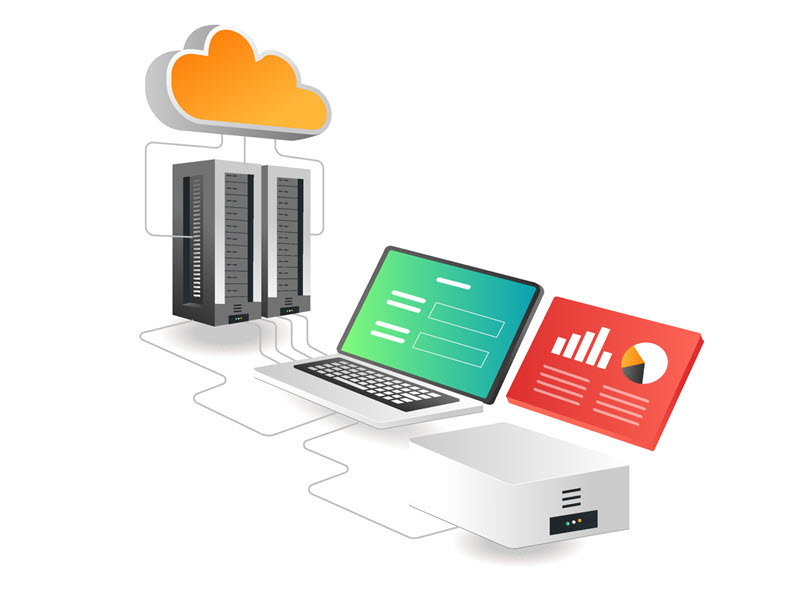
Database servers are required by nearly all modern applications, from websites and mobile apps to enterprise systems and analytics platforms. Depending on the workload, a database server can run a relational database (RDBMS) or a non-relational database (NoSQL).
Database server examples include:
- MySQL. One of the most widely used relational database management systems that implements the SQL standard. It supports web applications, websites, and content management systems like WordPress and Joomla.
- PostgreSQL. An open-source relational database known for standards compliance, extensibility, and advanced features such as JSON support, indexing, and concurrency control.
- MariaDB. A community-developed fork of MySQL focused on open-source governance and performance improvements.
- MongoDB. A cross-platform, document-oriented NoSQL DBMS that stores data in flexible JSON-like formats. Commonly used in modern JavaScript stacks and microservices.
- Redis. An in-memory key-value store used for caching, session management, message queues, and real-time analytics. Known for speed and simplicity.
- Elasticsearch. A distributed search and analytics engine optimized for full-text search, log analysis, and real-time data exploration. Often used alongside the ELK Stack (Elasticsearch, Logstash, Kibana).
The following table outlines database servers, data types, use cases, and deployment environments:
| Database Server | Stack Components | OS | Containerized Deployment | Used For |
|---|---|---|---|---|
| MySQL (RDBMS) | MySQL Server, MySQL CLI, or Adminer, and optional replication tools. | Linux, Windows | Docker, Bitnami, MAMP | Traditional web apps, CMS, and small-to-medium data sets. |
| PostgreSQL (RDBMS) | PostgreSQL, pgAdmin, PostGIS, extensions. | Linux, Windows, BSD | Docker, Helm, Kubernetes | Advanced data models, analytics, and geospatial data. |
| MariaDB (RDBMS) | MariaDB Server, Galera Cluster (optional). | Linux | Docker, MariaDB container | Open-source MySQL alternative, faster writes. |
| MongoDB (NoSQL) | MongoDB Server, Compass GUI, Replica Set config. | Linux, macOS, Windows | Docker, Atlas, Kubernetes | JSON-like documents, MERN stack, microservices. |
| Redis (NoSQL) | Redis Server, Redis CLI, Sentinel, Cluster. | Linux, BSD | Docker, Redis Stack | Caching, queues, session storage, and real-time apps. |
| Elasticsearch (NoSQL) | Elasticsearch, Kibana (UI), Logstash, or Beats. | Linux | Docker, Elastic Stack images | Log analysis, search engines, and observability. |
DNS Server
DNS servers translate the human-readable domain names into machine-readable IP addresses through a process called DNS resolution. While anyone can use public DNS servers (like Google or Cloudflare) for general browsing, enterprises often combine public and private DNS servers to meet internal and security requirements.
Therefore, private DNS servers are necessary when internal DNS data must remain confidential or isolated from public infrastructure. In addition, they enable organizations to enforce DNS-based access controls and improve local resolution speed without exposing sensitive queries.
Note: The function of a DNS server depends on its designated role within the DNS hierarchy (e.g., authoritative, recursive, forwarding). Learn about different DNS server types and how they work together to resolve domains efficiently.
DNS server software used in a private environment includes:
- BIND. The most widely used open-source DNS server supports authoritative and recursive roles with full zone management capabilities.
- Unbound. A modern, lightweight DNS resolver optimized for speed and security. Often used as a caching forwarder.
- PowerDNS. A flexible, API-driven DNS server with support for SQL backends, REST APIs, and DNSSEC.
- Microsoft DNS Server. Integrated into Windows Server and Active Directory environments for internal domain and host resolution.
- dnsmasq. A lightweight DNS forwarder and DHCP server, ideal for small networks, embedded devices, and containerized environments.
The following table outlines DNS server stacks, their typical roles, use cases, and deployment options:
| DNS Server | Role | Stack Components | OS | Containerized Deployment | Used For |
|---|---|---|---|---|---|
| BIND | Authoritative, Recursive | BIND (named), Zone files, ACLs, DNSSEC | Linux, BSD | Docker, Manual builds | Hosting public zones and internal name resolution. |
| Unbound | Recursive, Caching | Unbound, optional forwarding rules, DNSSEC | Linux | Docker, Kubernetes | DNS caching, upstream resolution, and DNS privacy. |
| PowerDNS | Authoritative | PowerDNS, MySQL, or PostgreSQL backend, REST API | Linux | Docker, Helm Charts | Managed DNS services, dynamic DNS records. |
| Microsoft DNS | Authoritative, AD-integrated | Windows DNS Service, Active Directory integration | Windows Server | Hyper-V, Native | Internal name resolution in Windows environments. |
| dnsmasq | Forwarder, DHCP | dnsmasq, DHCP server, local zone configs | Linux | Docker, Embedded use cases | Lightweight internal DNS, small networks. |
Proxy Server
A proxy server is an intermediary system between a client device and the broader internet. When a client requests a web resource, the proxy intercepts the request, forwards it to the destination server, retrieves the content, and returns it to the client.
In enterprise and educational environments, proxies are often used to monitor and restrict internet usage, mask client IP addresses, reduce bandwidth consumption through caching, and enforce network security policies by filtering specific domains or content types.
Note: Learn about the different types of proxy servers and how they are used in the wider network topology.
Proxy server software includes:
- Squid. A widely used caching and forwarding proxy server that supports HTTP, HTTPS, and FTP. Used in schools, ISPs, and corporate networks.
- HAProxy. A high-performance reverse proxy and load balancer used in high-availability and high-traffic web environments.
- NGINX. A lightweight web server often configured as a reverse proxy for HTTP and TCP/UDP traffic, with built-in load balancing and caching support.
- Apache Traffic Server. A scalable proxy and caching solution designed for large-scale deployments.
- 3proxy. A lightweight proxy server suite is suitable for small-scale deployments and development or embedded use cases.
- Privoxy. A non-caching, privacy-enhancing web proxy with ad blocking and content filtering support.
The following table lists proxy server software, the type of proxy, typical use cases, supported protocols, and deployment options:
| Proxy Server | Type | Supported Protocols | OS | Containerized Deployment | Used For |
|---|---|---|---|---|---|
| Squid | Forward Proxy | HTTP, HTTPS, FTP | Linux, BSD | Docker, Custom builds | Caching, access control, and content filtering. |
| HAProxy | Reverse Proxy | HTTP, HTTPS, TCP | Linux | Docker, Kubernetes | Load balancing, SSL termination, and high-traffic apps. |
| NGINX | Reverse Proxy | HTTP, HTTPS, TCP, UDP | Linux, BSD, Windows | Docker, NGINX official image | Load balancing, caching, and static content delivery. |
| Apache Traffic Server | Reverse Proxy | HTTP, HTTPS | Linux | Docker, Custom builds | High-performance content delivery and caching. |
| 3proxy | Forward/Mixed | HTTP, HTTPS, SOCKS | Linux, Windows | Docker, Embedded use | Lightweight multi-protocol proxy in small setups. |
| Privoxy | Forward Proxy | HTTP (non-caching) | Linux, Windows | Docker, Lightweight containers | Privacy filtering, ad blocking, and header control. |
DHCP Server
A Dynamic Host Configuration Protocol (DHCP) server automatically assigns IP addresses and other configuration parameters, like subnet masks, default gateways, and DNS servers, to a client device when it connects to the network.
Most DHCP solutions are deployed in enterprise LANs, wireless networks, and home routers as single-purpose services and require minimal dependencies and technology stacks.
Examples of DHCP server software include:
- Kea DHCP. Kea is built for high performance and modularity. It supports DHCPv4 and DHCPv6 with dynamic reconfiguration, RESTful API integration, and optional MySQL/PostgreSQL backends.
- dnsmasq. A lightweight DHCP and DNS forwarder used in small networks, embedded devices, or edge routers. It's often bundled with firmware like OpenWRT and is valued for its low resource usage, simple configuration, and integration with local DNS resolution.
- Microsoft DHCP Server. Integrated into Windows Server, this DHCP solution is commonly deployed in enterprise Windows environments.
- UDHCPD. A compact DHCP server daemon for lightweight, resource-constrained deployments such as IoT devices. It is included in the BusyBox suite and is designed for minimal Linux environments and embedded systems.
The following table compares DHCP server software:
| DHCP Server | Type | Supported Protocols | OS | Containerized Deployment | Used For |
|---|---|---|---|---|---|
| ISC DHCP Server | DHCPv4 and DHCPv6 | DHCP, BOOTP | Linux, BSD | Docker, Custom images | Legacy enterprise deployments; static/dynamic address assignment. |
| Kea DHCP | Modular DHCP server | DHCPv4, DHCPv6 | Linux, BSD, macOS | Docker, Kubernetes ready | High-performance environments, dynamic API-based config, and scalability. |
| dnsmasq | Lightweight DHCP | DHCP, TFTP, DNS | Linux, OpenWRT, Embedded | Docker, Alpine builds | Small networks, routers, and embedded devices with a low memory footprint. |
| Microsoft DHCP Server | Integrated DHCP | DHCPv4 | Windows Server | Windows containers (limited) | Windows-centric networks with Active Directory and DNS integration. |
| UDHCPD (BusyBox) | Minimal DHCP server | DHCP | Embedded Linux, Minimal distros | Docker, BusyBox images | Lightweight DHCP in embedded systems or resource-constrained deployments. |
File Server
A file server is a specialized system that stores, manages, and distributes files within a network. The centralized file storage allows users to retrieve, upload, and modify files from a shared location.
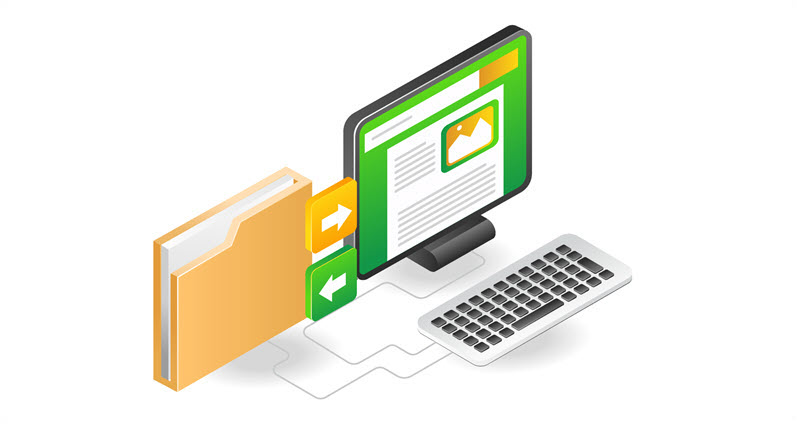
File servers typically use standard file-sharing protocols like SMB, NFS, or FTP to ensure interoperability between Linux-based, Windows, and macOS systems. This feature is essential for business environments because it simplifies user collaboration and provides greater access controls.
Notable file server software includes:
- Samba. An open-source implementation of the SMB/CIFS protocol. It allows Linux and Unix systems to share files and printers with Windows machines, ideal for mixed-OS environments.
- Windows File Server. A fully integrated file-sharing service built into Windows Server. It is optimized for Active Directory domains and large-scale enterprise environments.
- NFS Server. A native file-sharing service on most Linux distributions offers high-performance access and compatibility with Unix/Linux clients.
- FileZilla Server. An easy-to-configure FTP/SFTP server for Windows. It is suited for small businesses or setups requiring secure remote file access.
- Synology DSM. A proprietary file server platform built into Synology NAS devices. It provides a web-based interface, user management, and cross-platform file access for SMBs and home offices.
- Nextcloud/ownCloud. Open-source file hosting and sharing platforms. They can be used as self-hosted alternatives to cloud storage services like Dropbox or Google Drive.
The following table lists file server software, typical use cases, supported protocols, and deployment options:
| File Server Software | Protocol(s) Supported | OS/Platform | Containerized Deployment | Used For |
|---|---|---|---|---|
| Samba | SMB, CIFS | Linux, Unix, BSD | Docker, Official image | File and print sharing in cross-platform networks (Linux ↔ Windows). |
| Windows File Server | SMB, DFS, NFS (via role) | Windows Server | Windows containers (limited) | Enterprise file sharing, AD integration, group policy, and permission control. |
| NFS Server | NFSv3, NFSv4 | Linux, Unix (built-in) | Docker, Alpine, or base images | Fast file sharing in Linux/Unix environments and mixed-OS data centers. |
| FileZilla Server | FTP, FTPS, SFTP | Windows | Docker, Unofficial builds | Lightweight FTP/SFTP server for remote access or small-scale deployments. |
| Synology DSM | SMB, AFP, NFS, WebDAV, FTP | Synology NAS (Linux-based) | Virtual DSM available | Turnkey NAS and file server solution with rich UI and cross-platform support. |
| Nextcloud/ownCloud | HTTPS, WebDAV | Linux, Docker, Hosted | Docker, Kubernetes-ready | Secure file hosting, collaboration, and private cloud alternatives to Dropbox. |
Gaming Server
A game server is a dedicated system designed to host multiplayer video games. They often run on bare metal or virtual machines with high-performance CPU and GPU resources to support large player counts, real-time world updates, and reduced network latency.
Note: phoenixNAP offers a portfolio of dedicated game servers with built-in performance accelerators, advanced memory configurations, and flexible storage options for running demanding multiplayer games like Minecraft, CS, ARK: Survival Evolved, and Team Fortress 2.
Notable game server software includes:
- Minecraft Server (Java/Bedrock Editions). Official server software from Mojang. Enables players to create and manage custom Minecraft multiplayer worlds.
- SteamCMD. A command-line tool from Valve for installing and managing dedicated servers for Steam-based games like CS:GO, ARK, Team Fortress 2, and Garry's Mod.
- FiveM. A third-party server framework for Grand Theft Auto V. Supports custom scripts, roleplay servers, and multiplayer modifications.
- Factorio Headless Server. A lightweight, standalone server used for multiplayer sessions of the Factorio automation game.
- Palworld Dedicated Server. Used to host persistent custom sessions in the survival-action game Palworld.
- Garry’s Mod Server. A Lua-scriptable sandbox multiplayer server, often deployed using SteamCMD and highly customizable for modding communities.
The following table lists supported games, OS/platform compatibility, container support, and typical server software use cases:
| Game Server Software | Supported Game(s) | OS / Platform | Containerized Deployment | Used For |
|---|---|---|---|---|
| Minecraft Server (Java/Bedrock) | Minecraft (Java and Bedrock editions) | Windows, Linux | Docker, Community images | Hosting custom Minecraft worlds with mod/plugin support. |
| SteamCMD | CS:GO, ARK, Team Fortress 2, Garry's Mod, etc. | Windows, Linux, macOS | Docker, Kubernetes-ready | Installing, updating, and managing Steam-based dedicated game servers. |
| FiveM | Grand Theft Auto V | Windows, Linux | Docker, Community scripts | Hosting modded or roleplay GTA V multiplayer servers. |
| Factorio Headless Server | Factorio | Windows, Linux | Docker, Official headless image | Running persistent multiplayer sessions with automation scripts. |
| Palworld Dedicated Server | Palworld | Windows (Linux unofficial) | Docker (community) | Hosting co-op or PvP multiplayer Palworld sessions. |
| Garry's Mod Server | Garry's Mod | Windows, Linux (via SteamCMD) | Docker, SteamCMD builds | Hosting sandbox servers with Lua-based modding and custom maps. |
Print Server
A print server distributes print jobs from multiple client devices to one or more network-connected printers. The server prioritizes and queues jobs to ensure documents are routed to the appropriate device securely and efficiently.
Organizations deploy these servers to reduce overhead, enforce print policies, and streamline resource usage by centralizing printer administration.
Notable print server software and tools include:
- CUPS (Common UNIX Printing System). An open-source print server standard for Linux and macOS environments. It supports modern printing workflows, including PDF and IPP (Internet Printing Protocol).
- Windows Print Server. Integrated with Windows Server. Offers centralized printer and driver management across domains.
- Papercut MF/NG. Commercial print management software with advanced reporting, user quotas, secure print release, and multi-platform support.
- PrintNode. A cloud-based print service designed for remote print job delivery and integration with SaaS and web-based apps.
- LPR/LPD (Line Printer Daemon Protocol). Many network printers and basic print servers still support this legacy Unix-based protocol for backward compatibility.
The table outlines protocol support, platform compatibility, deployment style, and typical usage scenarios for print server software:
| Print Server Software | Supported Protocol(s) | OS / Platform | Containerized Deployment | Used For |
|---|---|---|---|---|
| CUPS | IPP, LPD, SMB | Linux, macOS, Unix | Docker, Official images | Standard print server for Unix/Linux systems; supports desktop and enterprise use. |
| Windows Print Server | SMB, IPP, WSD | Windows Server | Windows containers (limited) | Centralized printer management in Windows domains with Active Directory integration. |
| PaperCut MF/NG | IPP, SMB, LPD, Web Print | Cross-platform (Windows, Linux, macOS) | Docker, Custom builds | Enterprise print tracking, secure printing, quotas, and advanced reporting. |
| PrintNode | HTTPS, IPP, custom API | Cross-platform (cloud-based) | Native SaaS, API integration | Cloud-native remote printing for web apps and multi-location environments. |
| LPR/LPD | LPD | Unix, Linux, legacy systems | Lightweight container images | Legacy protocol for basic printing; still supported by many network printers. |
Maintaining Your Own Server Software - Advantages and Disadvantages
Servers are usually managed remotely using SSH terminal access or web-based control panels such as cPanel or Webmin. If you do not use a hosted or managed server solution, you have complete control over how your servers and security policies are configured.

However, this also means you are responsible for managing the technical complexity of running and maintaining multiple software components.
Advantages
The benefits of managing your own server software include:
- Complete control. You can stack the software according to the needs, including deployment methods, performance tuning, non-standard port assignments, and database optimization.
- Custom security policies. All security measures, firewall rules, patch management, SSL/TLS configuration, user access, and audit logging are fully under your control, without third-party limitations.
- No vendor lock-in. You can redeploy or reconfigure servers as your needs evolve. There is no vendor to tie you to specific components or long-term contracts.
- Building in-house know-how. Setting up and maintaining your own servers helps your technical team build valuable, infrastructure-specific knowledge, which is useful for debugging and optimizing server performance in the long run.
- Lower cost for long-term projects. A self-managed solution can be more cost-effective than fully managed services, especially when leveraging open-source tools and internal staff to handle maintenance and support.
Disadvantages
The challenges of managing your own server software include:
- Full responsibility for setup and maintenance. You are responsible for the entire lifecycle, initial setup, configuration, patching, updates, monitoring, and troubleshooting. This process can be time-consuming and technically demanding.
- Security risks. Without managed support, it is easier to misconfigure settings, set up weak access controls, or miss critical updates. If there is no service-level agreement (SLA), you are responsible for fixing the issue, which can lead to downtime or liability.
- Additional staff. If your organization lacks in-house expertise, you may need to hire dedicated staff or consultants to handle specific technical tasks.
- Scalability. Scaling infrastructure up or down requires manual planning, implementation, and testing, which can lead to unexpected delays or higher costs.
Conclusion
The software components listed in this guide help set up a functional server environment based on the type of server you plan to deploy.
If you are working with a Linux server, check out our Linux Network Commands guide for a quick refresher.
